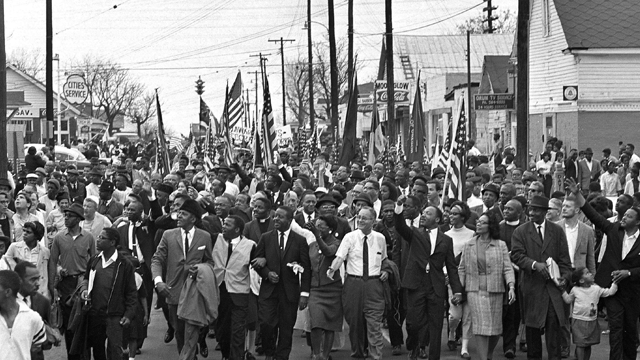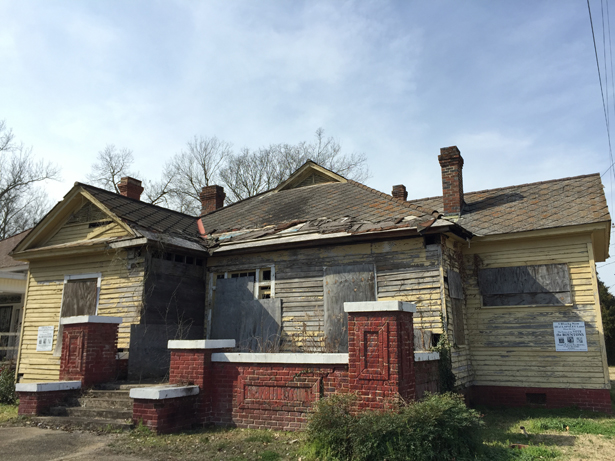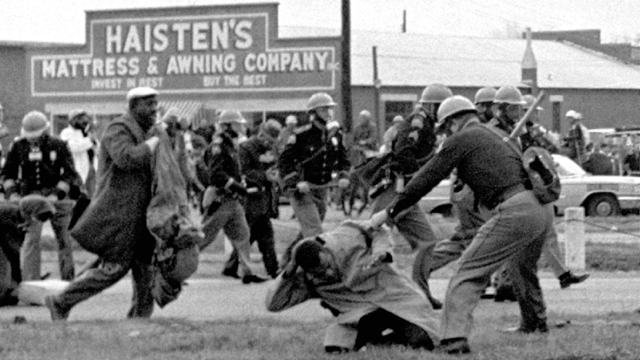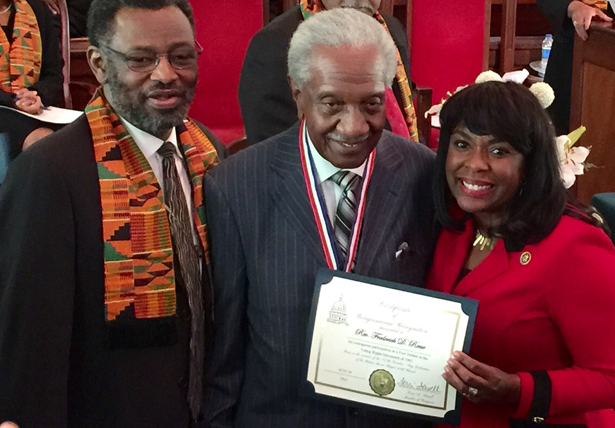This post first appeared at The Nation.

In this March 21, 1965 file photo, Dr. Martin Luther King, foreground row, fifth from right, waves as marchers stream across the Alabama River on the first of a five day, 50-mile march to the state capitol at Montgomery, Ala. (AP Photo/File)
Congress can’t agree on much these days, but on February 11, the House unanimously passed a resolution awarding the Congressional Gold Medal — the body’s highest honor — to the foot soldiers of the 1965 voting-rights movement in Selma, Alabama.
The resolution was sponsored by Representative Terri Sewell, Alabama’s first black congresswoman, who grew up in Selma. Sewell was born on January 1, 1965, a day before Martin Luther King Jr. arrived in Selma to kick off the demonstrations that would result in passage of the Voting Rights Act (VRA) eight months later. On February 15, 2015, Sewell returned to Selma, which she now represents, to honor the “unsung heroes” of the voting-rights movement at Brown Chapel A.M.E. Church, the red brick headquarters for Selma’s civil-rights activists in 1965, taking the pulpit where King once preached.
The film Selma has brought renewed attention to the dramatic protests of 1965. Tens of thousands of people, including President Obama, will converge on the city on March 7, the 50th anniversary of “Bloody Sunday,” when 600 marchers, including John Lewis, now a Congressman, were brutally beaten by Alabama state troopers.
At Brown Chapel, Sewell stressed the disturbing parallels between the fight for voting rights then and now. She cited the Supreme Court’s gutting of the VRA in 2013 and the spread of voter-ID laws that disproportionately burden minority voters. “The assaults of the past are here again,” she said. “Old battles have become new again.” Sewell’s mother, Nancy, Selma’s first black city councilwoman, read the names of the two dozen foot soldiers as Sewell presented each of them with a gold certificate. The loudest applause greeted 85-year-old Frederick Douglas Reese, who strode down the aisle in a sharp pinstripe suit. “My principal!” Sewell called him.
Reese is the ultimate unsung hero — the most important figure in Selma’s voting-rights movement, but virtually unknown outside town. While president of the Dallas County Voters League in 1964, he signed the letter officially inviting King to Selma. As leader of the Selma Teachers Association, Reese led the first major march of black public school teachers in the segregated South; they sought to register to vote. He marched behind Lewis on Bloody Sunday and alongside King and his wife, Coretta, from Selma to Montgomery two weeks later. Molotov cocktails were thrown at his house, and he was fired from his job because of his activism, but Reese never wavered. In 1972, he became one of five black members elected to the City Council — Selma’s first black elected officials since Reconstruction. He was principal of Selma High School and superintendent of the city schools, and has pastored the Ebenezer Missionary Baptist Church for 50 years.
Civil-rights history is everywhere in Selma — streets are named after activists like Reese, J.L. Chestnut and Marie Foster, and the main road to Montgomery crosses the Edmund Pettus Bridge, where Bloody Sunday took place. Reese’s office is decorated with photos of him marching with King. “The Lord had me at the right place, at the right time, with no sense,” he says.
Sewell and Reese are living testaments to the impact of the VRA. In 1964, there were roughly 300 blacks registered to vote in the county. Today, every important office in Selma is led by an African-American, from Congress to the mayor to the chief of police. But a closer look shows how much progress has yet to be achieved.

The now-dilapidated house of Amelia Boynton Robinson, where Frederick Reese wrote the letter inviting Martin Luther King to Selma. (Photo: Ari Berman)
Reese wrote the letter inviting King to Selma at the house of Amelia Boynton Robinson, who at the age of 103 attended the State of the Union address this year as Sewell’s guest. Today that house is boarded up, as are so many of the small shotgun houses on the historically black east side of town. Some homes still don’t have plumbing or running water. Formerly middle-class black neighborhoods now resemble post-Katrina New Orleans.
The statistics are staggering — Dallas County was the poorest in Alabama last year, with unemployment double the state and national average. More than 40 percent of families live below the poverty line. The violent crime rate is five times the state average. The Alabama Policy Institute named Selma the “least Business-Friendly City” in the state. Selma describes itself as the “Queen City of the Black Belt,” but The Birmingham News more aptly labeled the region, named the Black Belt because of its rich soil, as “Alabama’s Third World.” Ten thousand white residents have left Selma in the past three decades, leaving it 80 percent African-American. There are nearly as many vacant buildings as occupied ones in the once picturesque downtown, and side streets are desolate.
Blacks now control Selma politically, but long-standing racial disparities persist. The west side, where most whites live, has tall pines, manicured lawns and the city’s only country club, which remains all-white. Despite Selma’s stark poverty, girls were playing tennis and the parking lot was filled with Escalades on a recent Saturday afternoon.
Old wounds have not healed in Selma, which was founded as a major slave-trading center. There are still rotting slave quarters in back alleys, and massive foundries that produced weapons for the Confederate Army still line the banks of the Alabama River. Every April, a month after the Bloody Sunday commemoration, hundreds come to town to re-enact the Battle of Selma, when Union troops burned the city to the ground. Some also pay respects to Confederate Gen. Nathan Bedford Forrest, the first grand wizard of the KKK, whose memorial in the city’s moss-draped Confederate cemetery describes him as “one of the South’s finest heroes.”
Selma remains defined by its past, whether it be 1865 or 1965. Too many people visit the Edmund Pettus Bridge (named after a Confederate general who led the Alabama Klan) and the voting-rights museum across the street but never dig any deeper. “We have to move beyond the bridge,” Sewell said at Brown Chapel. “It’s not just about one commemoration on one day. We have to live Selma.” The historical focus on Bloody Sunday — as important as it is — has too often obscured the many problems facing the city today. “Selma has done a lot more for the rest of the world than it has done for itself,” the city’s first black mayor, James Perkins, often says.
In Selma, it feels like everything and nothing has changed.
* * *

In this March 7, 1965 file photo, state troopers use clubs against participants of a civil rights voting march in Selma, Ala. At foreground right, John Lewis, chairman of the Student Nonviolent Coordinating Committee, is beaten by a state trooper. The day, which became known as “Bloody Sunday,” is widely credited for galvanizing the nation’s leaders and ultimately yielded passage of the Voting Rights Act of 1965. (AP Photo/File)
Four days after the passage of the VRA in August 1965, federal examiners from the US Civil Service Commission arrived in town to begin registering voters. The first blacks registered under the act were signed up in Selma. By the time of the first major election in Alabama following the VRA, in May 1966, the number of black registered voters in Dallas County had surged from well under 1,000 before the VRA to over 10,000.
Black voters finally had a chance to get even with Dallas County Sheriff Jim Clark, who had tyrannically enforced segregation for over a decade. In the 1966 primary, Selma’s moderate Public Safety Director, Wilson Baker, squared off against Clark for sheriff. Newly enfranchised African-Americans embraced Baker’s candidacy, and it was expected that with all ballots in, Baker would defeat Clark with enough votes to avoid a runoff.
But the next morning, Clark’s allies on the Dallas County Democratic Executive Committee tried to steal the election, refusing to count six boxes of ballots from Selma’s black wards, which they claimed were “infected with irregularities.” The Justice Department immediately sought an injunction from the federal courts, which ruled in its favor under the VRA. The ballots were counted, and Clark, a major foe of the civil-rights movement, was finally out of a job. It was the first symbol of how consequential the new law would be, and also signaled that any progress in Selma would not come without a major fight.
“The Voting Rights Act had a tremendous impact on Selma, particularly when there were certain blacks who were initially skeptical about going to the courthouse to get registered,” Reese says. “After it was passed, we were able to convince many people to register and cast a ballot.”
Electing blacks to office would be a harder task. Seven years after Bloody Sunday, the number of black registered voters had reached near parity with white voters, but there were still no black elected officials in Dallas County. That was because candidates for offices like the Selma City Council were elected “at large” — citywide instead of by district. Since whites retained a slight voter-registration advantage, they were able to elect all of their preferred candidates. The black half of town remained effectively disenfranchised. At-large elections were the chief obstacle to minority representation in the years following passage of the VRA, not just in Selma but throughout the country.
When Selma civil-rights lawyer J.L. Chestnut threatened to sue the ten-member City Council under the VRA, the town’s white leaders unexpectedly agreed to shift to district-based elections. As a result, five blacks, including Reese, were elected to the City Council. Reese would become the second most powerful figure in city government. “Even white people had to go through him if they wanted a stop sign,” wrote Chestnut.
* * *
But just as Selma was integrating politically, its economy collapsed. Craig Air Force Base, where thousands of pilots had been trained since World War II, closed in 1977. The base had housed over 2,500 people and contributed $5 million a year to the city’s economy. “I saw my town dry up,” Sewell says. “You no longer had people coming from across the country to make Selma their home.”
Economic challenges raised the stakes for political control of the area. In 1978, the Justice Department sued the all-white Dallas County Commission and school board under Section 2 of the VRA, alleging that at-large elections for county offices prevented black candidates from winning. Reese was one of the lead plaintiffs. Judge William Brevard Hand, a notorious racial conservative, ruled twice against the department and bottlenecked the lawsuit. It took 10 years — and multiple trips to the appeals court — before Hand relented and ordered the county to draw new districts for the county commission and school board, which elected blacks for the first time in 1988.
The integration of county government took far longer than anyone expected. “There was a gross underestimation of the obstacles to voting when the 1965 Voting Rights Act was passed,” says State Senator Hank Sanders, who in 1983 became Selma’s first black state representative.
In 1989, U.W. Clemon, Alabama’s first black federal judge, swore in three black commissioners at the Dallas County Courthouse — the first black commissioners in 112 years. “We bring home to Dallas County the harvest of the Martin Luther King Voting Rights Act,” Clemon said. Reese delivered the invocation. “Out of the Egypt of Selma,” he said, “you brought us from nowhere to somewhere.” Justice Department lawyers flew down for the ceremony. “I predict that some day students of modern history will point to Selma, Alabama, as 20th-century America’s cradle of democracy,” said Jim Turner, who was acting assistant attorney general for civil rights.
But racial strife soon followed. In 1990, the Selma school board, which whites controlled six to five, fired the city’s first black superintendent, Norward Roussell, who was previously area superintendent of the New Orleans schools. Black school board members walked out in protest. Picketers descended on City Hall, and black students staged a five-day sit-in at Selma High School. The National Guard was sent in to restore order. Six hundred white students were pulled out of public schools by their parents and never returned. Selma High became 99 percent black. The school system never recovered, and last year it was taken over by the state because of poor performance. “It’s resegregated,” says Sewell, the first black valedictorian at Selma High. “I wonder if my old high school could reproduce me today.”
Black residents focused their ire on Mayor Joe Smitherman, who, according to Newsweek, called Roussell “an overpaid nigger from New Orleans.” (Smitherman denied the accusation.) Smitherman had been in office since 1964, craftily winning election after election with the help of a powerful patronage machine. Reese had unsuccessfully run against him in 1984, but in 2000 Reese’s campaign manager, James Perkins, finally ousted Smitherman, becoming Selma’s first black mayor. “It was powerful symbolically,” says Hank Sanders. “Selma had given the nation the Voting Rights Act, and yet Selma still had the same mayor who was here in 1965 in the year 2000.”
Perkins, a computer technician, brought new industries to Selma, raised the minimum wage for city employees, put African-Americans in charge of city departments and improved services in the black community. In 2008, George Evans, the first black president of the City Council, replaced Perkins as mayor. But neither Perkins nor Evans has been able to reverse many of the problems facing the city: chronic unemployment, segregated schools, high crime, aging infrastructure.
Selma is not Ferguson; black political power is a fact of life here. Economic power is another story. “The biggest obstacle has been that even when there is black electoral power, the economic power is nearly all white,” Sanders says. For example, in 2009, blacks made up 27 percent of Alabama’s population, but owned only 3 percent of the state’s agriculture and 2 percent of its timberland — the largest industries in the Black Belt. Amendments to the Alabama Constitution, pushed through by Gov. George Wallace in the 1970s following integration of the state’s schools, taxed agriculture and timberland at only 10 percent of market value, depriving areas like Selma of millions of dollars in revenue. As a result, “the children of the rural poor, whether black or white, are left to struggle as best as they can in underfunded, dilapidated schools,” District Court Judge Lynwood Smith wrote in 2011.
Selma, says Sewell, is “emblematic of rural communities across this nation that have been left behind.”
* * *
Sean and Tylisa Black moved from Denver to Selma in 2007, after Sean visited on a civil-rights pilgrimage. It was too late to enroll their 4-year-old daughter, Shania, in public school, so they sent her to a predominantly white private pre-school. When it came time for kindergarten, Shania told her parents she wanted to attend Morgan Academy, a segregated private school founded by whites three months after Bloody Sunday. Morgan was named after Alabama Senator John Tyler Morgan, a Confederate general and a grand dragon of the KKK in the 1870s. Morgan Academy had never accepted an African-American student, but the Blacks applied for Shania, and, to their surprise, she was admitted.
They were told to expect 25 people at the first parents meeting. Five hundred showed up, packing the school’s gym: parents, aunts, grandparents and alumni. “Our heritage is being ruined,” Sean remembers hearing over and over again. One board member resigned on the spot. Dallas County District Court Judge Bob Armstrong leaned over and told Sean, “I’m sorry. This kind of behavior reminds me of the 1960s.”
Shania was not personally bullied, but older siblings of her friends were beat up and called “nigger lovers.” She couldn’t sleep over at her white friends’ houses, and nobody from her school would come to her birthday parties. Graffiti on the back of Walmart depicted Shania being lynched. “Nigger” it said, pointing to her head. “Hang the bitches,” it said below, next to “MLK is a homosexual” and a drawing of a swastika. Shania spent two unhappy years at Morgan before leaving for the public elementary school. Now in sixth grade, she attends a private “freedom school” affiliated with the Selma Community Church, the only truly integrated church in town.
A mentoring program that Sean and Tylisa started for at-risk kids at the courthouse was defunded after Shania enrolled at Morgan. The retribution didn’t end there. The Blacks moved to town along with 57 other members of a Denver nonprofit called the Freedom Foundation, which focuses on youth empowerment and social justice issues. The new arrivals, determined to challenge Selma’s segregated institutions, met with Reese for guidance and encouragement. The group’s founder, Mark Duke, bought a grand Victorian mansion in an integrated neighborhood near downtown. After Shania enrolled at Morgan, vandals covered his house in toilet paper and spray-painted “Go Home” on his lawn. He received death threats, and an anti-Freedom Foundation website was started by white supremacists. The Department of Homeland Security came to investigate. Duke relocated his family to Atlanta after two years. “When I moved here, I thought most of these issues were gone,” he says. “I was shocked to see the depths of it.”
Race is far more of a factor in Selma than the Blacks anticipated. “It’s like when you come to Alabama and you have to pick Alabama or Auburn as your team,” Sean says. “When you come to Selma, you have to pick a side.”
The unyielding racial divide in Selma is emblematic of the problems facing the city. “Everybody knows the 50th anniversary is coming up, so if you look around the city, there’s a lot of action and covering things up to make sure things look good, when it’s really falling apart,” Sean says. “If we don’t look at why it’s falling apart, then how can we move forward?”
* * *
On July 27, 2006, President George W. Bush signed legislation reauthorizing the VRA for another 25 years. He invited Selma Mayor James Perkins to the Rose Garden signing ceremony and thanked him in his speech. Seven years later, the Supreme Court struck down the most important part of the VRA, the requirement that states with the worst histories of voting discrimination, like Alabama, approve voting changes with the federal government. Announcing the decision from the bench, Chief Justice John Roberts cited the election of a black mayor in Selma as a reason why the VRA’s powerful federal oversight was no longer needed.

Rep. Terri Sewell (right) presents a gold certificate to Frederick Douglas Reese (center), with the Rev. Leodis Strong, at Brown Chapel A.M.E. Church, February 2015. (Photo: Ari Berman)
Perkins finds that deeply ironic. “The gutting of the act was synonymous with gutting the people who worked so hard to achieve the act in the first place,” Perkins says, thinking of his mentor, Reese. “I took it personally. When you are part of the change, and you see those changes reversed and know they were for the better, it really hurts.” Selma was not just the birthplace of the VRA; the law protected minority voters from discriminatory election schemes on more than 10 different occasions from the 1970s to the ’90s.
Legislation to strengthen the VRA in the wake of the Court’s decision has gone nowhere in Congress. The House unanimously approved Sewell’s bill honoring the foot soldiers of Selma, but only eleven Republicans have sponsored the Voting Rights Amendment Act of 2014 in the House, and none in the Senate.
It remains to be seen whether Congress can move from symbolism to substance on civil rights. Sewell and Lewis recently screened Selma at the Capitol with Republican lawmakers and plan to welcome a large bipartisan delegation to Alabama for the anniversary of Bloody Sunday.
“My hope is that the bipartisan efforts we’ve made will move people to recommit themselves to restore the teeth back into the Voting Rights Act,” Sewell says. “Gold medals are great — I think it’s long overdue and much deserved that the foot soldiers are going to finally get their place in history, but the biggest tribute that we can give to those foot soldiers is fully restoring the Voting Rights Act.”
Selma transformed America. It’s time for America to repay that debt.


